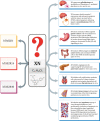An update on extra-oral bitter taste receptors
- PMID: 34674725
- PMCID: PMC8529754
- DOI: 10.1186/s12967-021-03067-y
An update on extra-oral bitter taste receptors
Erratum in
-
Correction to: An update on extra-oral bitter taste receptors.J Transl Med. 2021 Nov 26;19(1):478. doi: 10.1186/s12967-021-03137-1. J Transl Med. 2021. PMID: 34836552 Free PMC article. No abstract available.
Abstract
Bitter taste-sensing type 2 receptors (TAS2Rs or T2Rs), belonging to the subgroup of family A G-protein coupled receptors (GPCRs), are of crucial importance in the perception of bitterness. Although in the first instance, TAS2Rs were considered to be exclusively distributed in the apical microvilli of taste bud cells, numerous studies have detected these sensory receptor proteins in several extra-oral tissues, such as in pancreatic or ovarian tissues, as well as in their corresponding malignancies. Critical points of extra-oral TAS2Rs biology, such as their structure, roles, signaling transduction pathways, extensive mutational polymorphism, and molecular evolution, have been currently broadly studied. The TAS2R cascade, for instance, has been recently considered to be a pivotal modulator of a number of (patho)physiological processes, including adipogenesis or carcinogenesis. The latest advances in taste receptor biology further raise the possibility of utilizing TAS2Rs as a therapeutic target or as an informative index to predict treatment responses in various disorders. Thus, the focus of this review is to provide an update on the expression and molecular basis of TAS2Rs functions in distinct extra-oral tissues in health and disease. We shall also discuss the therapeutic potential of novel TAS2Rs targets, which are appealing due to their ligand selectivity, expression pattern, or pharmacological profiles.
Keywords: Bitter compounds; Bitter taste-sensing type 2 receptors (TAS2Rs); Cancer; Extraoral tissues; G-protein coupled receptors (GPCRs); Innate immunity; Muscle contractility; TAS2R polymorphisms.
© 2021. The Author(s).
Conflict of interest statement
The authors declare no conflict of interests.
Figures



Similar articles
-
Identification of novel compounds for human bitter taste receptors.Chem Biol Drug Des. 2014 Jul;84(1):63-74. doi: 10.1111/cbdd.12293. Epub 2014 Feb 28. Chem Biol Drug Des. 2014. PMID: 24472524
-
Bitter Taste Receptors in Bacterial Infections and Innate Immunity.Immun Inflamm Dis. 2025 Jul;13(7):e70232. doi: 10.1002/iid3.70232. Immun Inflamm Dis. 2025. PMID: 40709685 Free PMC article. Review.
-
Promiscuity and selectivity of bitter molecules and their receptors.Bioorg Med Chem. 2015 Jul 15;23(14):4082-91. doi: 10.1016/j.bmc.2015.04.025. Epub 2015 Apr 16. Bioorg Med Chem. 2015. PMID: 25934224
-
Genetic mutation of Tas2r104/Tas2r105/Tas2r114 cluster leads to a loss of taste perception to denatonium benzoate and cucurbitacin B.Animal Model Exp Med. 2024 Jun;7(3):324-336. doi: 10.1002/ame2.12357. Epub 2023 Dec 28. Animal Model Exp Med. 2024. PMID: 38155461 Free PMC article.
-
The bitter truth about bitter taste receptors: beyond sensing bitter in the oral cavity.Acta Physiol (Oxf). 2016 Apr;216(4):407-20. doi: 10.1111/apha.12621. Epub 2015 Nov 16. Acta Physiol (Oxf). 2016. PMID: 26493384 Review.
Cited by
-
Profiling bitter taste receptors (TAS2R) along the gastrointestinal tract and their influence on enterohormone secretion. Gender- and age-related effects in the colon.Front Endocrinol (Lausanne). 2024 Oct 17;15:1436580. doi: 10.3389/fendo.2024.1436580. eCollection 2024. Front Endocrinol (Lausanne). 2024. PMID: 39512758 Free PMC article.
-
Phenanthroline relaxes uterine contractions induced by diverse contractile agents by decreasing cytosolic calcium concentration.Eur J Pharmacol. 2024 Apr 5;968:176343. doi: 10.1016/j.ejphar.2024.176343. Epub 2024 Jan 26. Eur J Pharmacol. 2024. PMID: 38281680 Free PMC article.
-
Intracellular TAS2Rs act as a gatekeeper for the excretion of harmful substances via ABCB1 in keratinocytes.FASEB Bioadv. 2024 Aug 27;6(10):424-441. doi: 10.1096/fba.2024-00074. eCollection 2024 Oct. FASEB Bioadv. 2024. PMID: 39372126 Free PMC article.
-
Research on Bitter Peptides in the Field of Bioinformatics: A Comprehensive Review.Int J Mol Sci. 2024 Sep 12;25(18):9844. doi: 10.3390/ijms25189844. Int J Mol Sci. 2024. PMID: 39337334 Free PMC article. Review.
-
Improvement of Theaflavins on Glucose and Lipid Metabolism in Diabetes Mellitus.Foods. 2024 Jun 4;13(11):1763. doi: 10.3390/foods13111763. Foods. 2024. PMID: 38890991 Free PMC article. Review.
References
Publication types
MeSH terms
Substances
Grants and funding
LinkOut - more resources
Full Text Sources
Other Literature Sources

